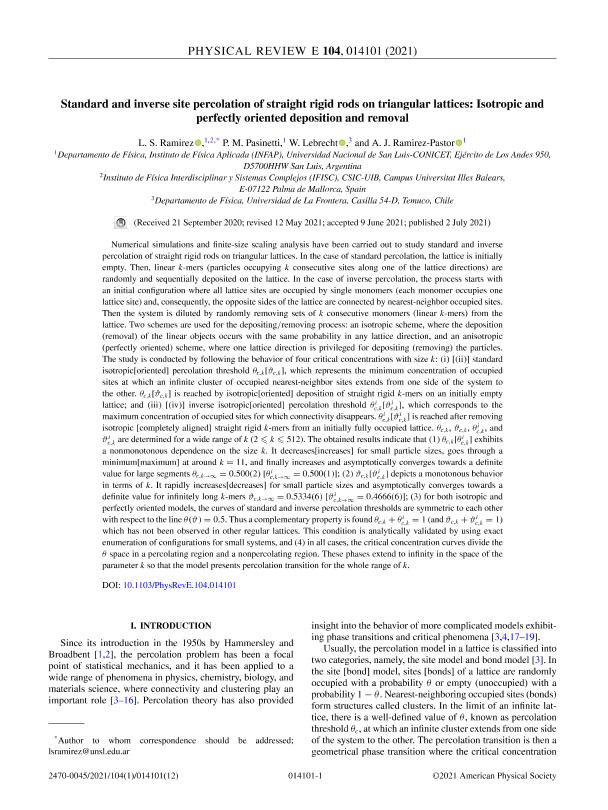Artículo
Standard and inverse site percolation of straight rigid rods on triangular lattices: Isotropic and perfectly oriented deposition and removal
Fecha de publicación:
07/2021
Editorial:
American Physical Society
Revista:
Physical Review E
ISSN:
2470-0045
e-ISSN:
2470-0053
Idioma:
Inglés
Tipo de recurso:
Artículo publicado
Clasificación temática:
Resumen
Numerical simulations and finite-size scaling analysis have been carried out to study standard and inverse percolation of straight rigid rods on triangular lattices. In the case of standard percolation, the lattice is initially empty. Then, linear k-mers (particles occupying k consecutive sites along one of the lattice directions) are randomly and sequentially deposited on the lattice. In the case of inverse percolation, the process starts with an initial configuration where all lattice sites are occupied by single monomers (each monomer occupies one lattice site) and, consequently, the opposite sides of the lattice are connected by nearest-neighbor occupied sites. Then the system is diluted by randomly removing sets of k consecutive monomers (linear k-mers) from the lattice. Two schemes are used for the depositing/removing process: an isotropic scheme, where the deposition (removal) of the linear objects occurs with the same probability in any lattice direction, and an anisotropic (perfectly oriented) scheme, where one lattice direction is privileged for depositing (removing) the particles. The study is conducted by following the behavior of four critical concentrations with size k: (i) [(ii)] standard isotropic[oriented] percolation threshold θc,k[ϑc,k], which represents the minimum concentration of occupied sites at which an infinite cluster of occupied nearest-neighbor sites extends from one side of the system to the other. θc,k[ϑc,k] is reached by isotropic[oriented] deposition of straight rigid k-mers on an initially empty lattice; and (iii) [(iv)] inverse isotropic[oriented] percolation threshold θc,ki[ϑc,ki], which corresponds to the maximum concentration of occupied sites for which connectivity disappears. θc,ki[ϑc,ki] is reached after removing isotropic [completely aligned] straight rigid k-mers from an initially fully occupied lattice. θc,k, ϑc,k, θc,ki, and ϑc,ki are determined for a wide range of k (2≤k≤512). The obtained results indicate that (1)θc,k[θc,ki] exhibits a nonmonotonous dependence on the size k. It decreases[increases] for small particle sizes, goes through a minimum[maximum] at around k=11, and finally increases and asymptotically converges towards a definite value for large segments θc,k→∞=0.500(2) [θc,k→∞i=0.500(1)]; (2)ϑc,k[ϑc,ki] depicts a monotonous behavior in terms of k. It rapidly increases[decreases] for small particle sizes and asymptotically converges towards a definite value for infinitely long k-mers ϑc,k→∞=0.5334(6) [ϑc,k→∞i=0.4666(6)]; (3) for both isotropic and perfectly oriented models, the curves of standard and inverse percolation thresholds are symmetric to each other with respect to the line θ(ϑ)=0.5. Thus a complementary property is found θc,k+θc,ki=1 (and ϑc,k+ϑc,ki=1) which has not been observed in other regular lattices. This condition is analytically validated by using exact enumeration of configurations for small systems, and (4) in all cases, the critical concentration curves divide the θ space in a percolating region and a nonpercolating region. These phases extend to infinity in the space of the parameter k so that the model presents percolation transition for the whole range of k.
Palabras clave:
Percolación
,
Jamming
Archivos asociados
Licencia
Identificadores
Colecciones
Articulos(INFAP)
Articulos de INST. DE FISICA APLICADA "DR. JORGE ANDRES ZGRABLICH"
Articulos de INST. DE FISICA APLICADA "DR. JORGE ANDRES ZGRABLICH"
Citación
Ramírez, Lucía Soledad; Pasinetti, Pedro Marcelo; Lebrecht, W.; Ramirez Pastor, Antonio Jose; Standard and inverse site percolation of straight rigid rods on triangular lattices: Isotropic and perfectly oriented deposition and removal; American Physical Society; Physical Review E; 104; 1; 7-2021; 1-12
Compartir
Altmétricas




